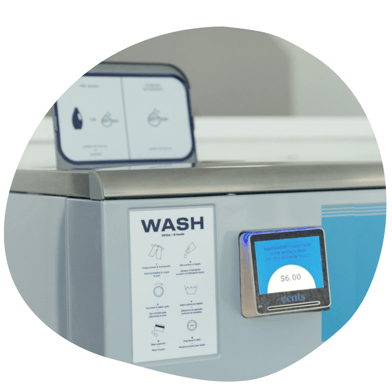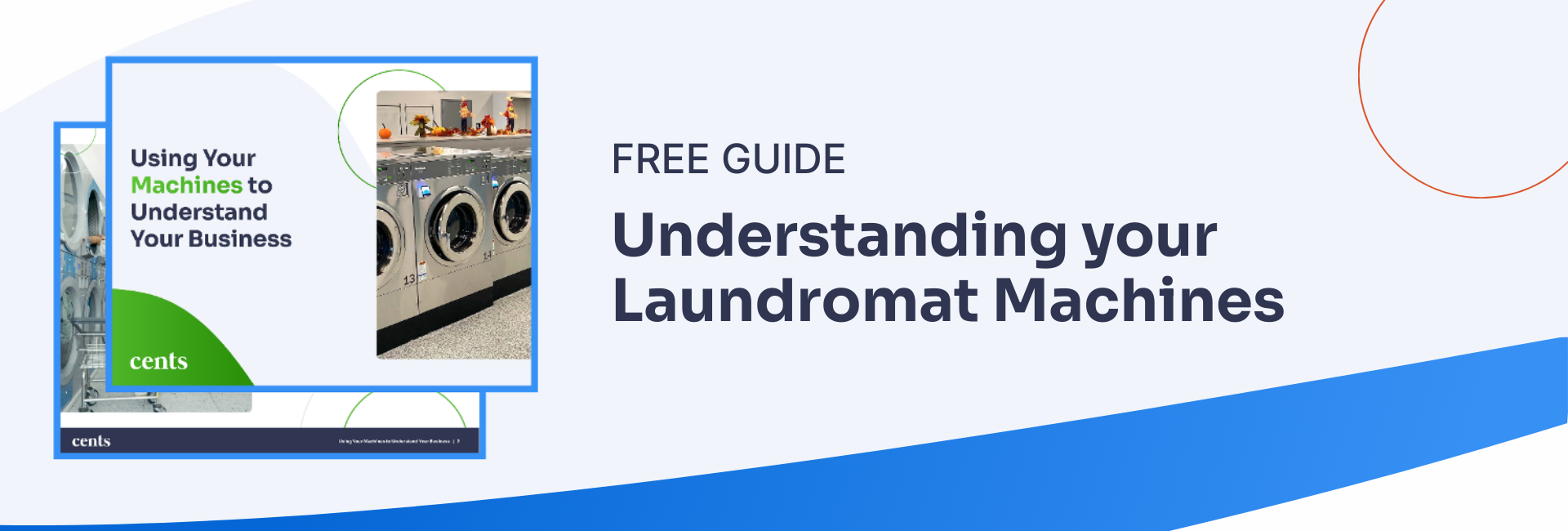The Laundry Bin’s successful card payment system transition
Luckily, you’re not entering uncharted territory. Many laundromats across the country have undergone the transition to modern payment systems and are reaping the benefits. Take the Laundry Bin for example.

In Pittsburgh's northern suburbs, Steve Burk's "The Laundry Bin" stands out as a beacon of innovation in the laundromat industry. Inspired by a gap in the market—homeowners traveling far for quality laundry services—Steve transformed a former Berkshire Hathaway training center into something the community really needed.
Instead of the usual quarters, Steve introduced dollar coins, reducing coin counting and theft. Further modernizing the experience, he integrated Cents Payment Systems card readers, providing customers with a diverse payment method, achieving a 60/40 card-to-coin ratio. Rejecting the outdated view of cramped laundromats, Steve's vision created a community-driven space with the best machinery and payment systems. His adoption of modern tech exemplifies the future of laundromats, enhancing customer experience and operational efficiency.
How to transition your laundromat from coin to card payments

1. Conducting a feasibility study
Before making the shift from coin to card laundry payments, make sure to do your due diligence. This analysis will help you understand the potential costs, benefits, and implications of a payment transition. Consider factors like customer preferences, operational changes, and ROI expectations.
2. Budget planning
When planning a budget for this type of project, you should factor in the costs associated with installing and setting up machines. The installation of each machine can range from $100 to $400. Other expenses include maintenance and repair, which can cost between $120 to $500 per service call. If you're considering transitioning to a card system, be prepared for significant costs. Card reader systems, for instance, can range anywhere from $5,000 to $15,000, depending on the number of machines and the features you opt for, such as loyalty programs. For a holistic view, remember that the median cost to open a laundromat from the ground up can reach approximately $1.2 million.
3. Installation steps
When setting up a new payment system for your laundromat, a meticulous installation process is incredibly important. The last thing you want is a poorly executed installation that renders your money-makers unusable! Here are the steps for a smooth installation:
- Consult with distributors: begin by consulting your distributor of choice. Many times, they offer installation services for their products. It can be especially helpful if the distributor also services your brand of laundry equipment.
- Schedule the installation: plan the installation during hours when the laundromat experiences the least traffic. This will allow you to reduce the downtime and minimize inconvenience to your customers. On that note, be sure to inform your regular customers in advance about the scheduled downtime to manage their expectations.
- Testing: once the installation is complete, test the machines to be sure they're operating correctly. This will help boost customer satisfaction and decrease machine downtimes in the future.
- Training: provide training to your staff on how to use the new system, handle queries, and troubleshoot minor issues. This step ensures smooth operations once the laundromat is back in service.
4. Employee training
Whenever there’s an upgrade as big as this at your laundromat, you should implement an employee training protocol. This ensures that all employees can remain productive and feel empowered to resolve issues with the new payment system as they arrive. There are two main aspects of training to focus on in this case:
- Troubleshooting skills: enhancing troubleshooting capabilities will come in handy. By offering a strong foundation of process training, employees can develop or refine their ability to find issues and fix them without a hitch. Employees that can address problems promptly are more productive and confident at work.
- Importance of ease of use: a user-friendly training program is a major facter in your employees retention of the material. If employees find the training content easy to understand and apply, they are more likely to absorb the knowledge and apply it in their roles. This not only gives them the ability to perform their jobs correctly but also keeps them updated with evolving industry trends and practices.
5. Customer education
Educating customers is a necessary step in the successful adoption of new payment systems. Here's how you can get the word out and get your customers on board:
- POS system information: implement an all-in-one business management system to easily control your entire operation, view data, manage employees, and set up preferences. This will lead to prepared staff and informed customers.
- Promote digital payments: get people excited about the benefits of digital laundry payments! This makes your customers' lives more convenient AND drives long-term growth for your laundry business. Educate customers on how these systems work and the security features in place.
- Comparison boards: Hang comparison visuals around the laundromat showing the difference between coin and card-based systems. This can help customers understand the advantages of each system.
- Use smartphone apps: introduce mobile apps designed specifically for laundromats. Apps can provide a platform for tutorials, FAQs, and direct customer support, giving customers easy access to information and assistance.
- Host informational sessions: host occasional in-store sessions explaining new features, payment methods, or any technological advancements. Always make workshops like these ultra customer-centric. Answer the question, how does this change benefit them?
Can you add a card reader to a washing machine?

Yes, you can add a card reader to a washing machine. Many modern machines are compatible with external card reader systems, and retrofitting options are also available for older models.
How long does it take to transition to a card payment system in a laundromat?
The transition time to implement a card payment system in a laundromat can vary based on various factors such as the size of the laundromat, the number of machines, the specific card payment system chosen, and any additional infrastructural changes needed. You can reasonably expect to spend between 5-11 weeks for the entire process.
Best practices for a seamless transition
Implementing a new payment system is a significant step in the direction of growth and profits, but only if done with precision and grace! Here are some of the important details that will make your transition to a future-forward payment go smoothly:
Soft-launch the new system
- Phased introduction: begin by introducing the new payment system to a subset of washing machines or dryers. Known as a soft launch, this step-by-step approach allows for early detection of issues and refinements.
- Diverse options: it's recommended to offer a variety of payment methods, such as coin, credit/debit card, mobile apps, and contactless payments like Apple Pay, to meet the needs of customers of all kinds.
Monitor and gather feedback
- Feedback stations: whenever you make a big change like this, you should create a process for collecting customer feedback. Put a suggestion box at the front desk, so customers can voice their opinions and you can iterate your new system to perfection.
- Digital benefits: change can be hard, even if it’s for the best! Clearly emphasize the benefits of digital payments to your customers, such as the ease of use and potential loyalty rewards.
Ongoing maintenance tips
- System flexibility: choose payment systems that are compatible with existing coin laundry machines. This will make transitioning more cost-effective, and there won't be a need for a complete overhaul.
- Educate customers: continuously educate customers about the different payment options available, whether it's through posters, digital screens, or staff interactions. This can help in alleviating any apprehensions in the transition process.
Transition tips from the experts
When looking to introduce new payment systems to your laundromat, considering the following expert recommendations can ensure a smooth transition and optimal customer satisfaction:
- Consultation with specialists: reach out to payment system vendors to get advice and learn more about all your options. Their specialized knowledge will guide you in selecting systems best suited for your unique needs.
- Educate your customers: the introduction of a new payment system can feel daunting to some customers. Utilize social media platforms and in-store signage to inform your customers about the features and benefits of the new system. Emphasizing the enhanced security features, like how contactless laundry payments don't transmit personal details like name or card number, can instill confidence.
- Leverage data analytics: one of the major benefits of a modern payment system is the new ability to gather valuable data about your customers' usage patterns. Use this data to launch targeted promotions and reward loyal customers.
Get started with Cents Payment Systems
Watch the video: The Laundroworks Payment System Drives Expansion to 10+ Storesstem
The transition to modern laundromat payment and management systems isn’t just a trend, but a necessity for your laundromats growth. By integrating systems like Cents Payment Systems, laundromat owners can provide customers with more convenient payment options, track prices efficiently, and even apply business insights in real-time. From improving operational efficiencies to enhancing customer experience, the advancements in technology bring laundromats into the future.
Take the first step towards a smarter, more efficient laundromat with Cents Payment Systems and redefine what it means to offer top-tier laundry services.
Discover the evolving laundry industry and the power of machines in customer loyalty and operational efficiency. Learn about Cents Connect, our suite of payment systems that integrates data from machines, offering convenience and data-driven decision-making for both customers and laundromat owners.
.png?width=2196&height=2196&name=OS%20(1).png)

-3.png?width=224&height=213&name=Accelerate%20(2)-3.png)








/Customer%20placing%20laundry%20card%20in%20VAC.jpg?width=400&height=200&name=Customer%20placing%20laundry%20card%20in%20VAC.jpg)

